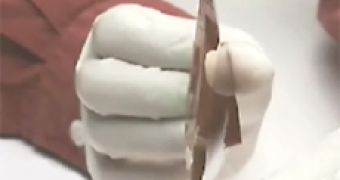The electronics industry is involved in a continuous race to make today's TV screens and cell phones more efficient, cheaper and of a higher quality. The race for developing the thinnest video display ever seems to have a winner. Sony just presented a paper-thin video display that bends like paper while showing full-color video.
At SID-2007 Sony shows the first full color flexible OLED Display. Producing a 2.5-inch prototype weighing only 1.5 grams, Sony is not the first OEM to work on producing the thin organic light emitting diode based screens. Sony is seeking to differentiate their product by being the first to use plastic instead of glass as the basis of the screen.
Sony unveiled footage of their new display, which presents itself in the form of a screen just under 7 cm wide and 0.3 millimeters thick. The footage also shows a human hand grabbing and squeezing a display that bends and is still able to display color images of a beautiful lake and of a stuntman on a bike.
Flexible displays are being researched by many companies, but commercial development of the technology is also restrained by patents held by Eastman Kodak and other firms, requiring other companies to acquire a license.
The new product is really a groundbreaking marketable technology, which could found use in many applications in flexible electronics. Flexible electronics - also known as flex circuits or flex circuit boards - represent a technology for building electronic circuits by depositing electronic devices on flexible substrates such as plastic or even organic materials. "In the future, it could get wrapped around a lamppost or a person's wrist, even worn as clothing," Sony spokesman Chisato Kitsukawa told the Associated Press (AP). "Perhaps it can be put up like wallpaper."
There are many advantages in developing these flexible materials, like package size reduction, a simplified system design, considerable weight and thickness reduction, and the fact that they can dissipate heat at a better rate than any other dielectric material while providing the added benefits of vastly improved flexibility.

 14 DAY TRIAL //
14 DAY TRIAL //